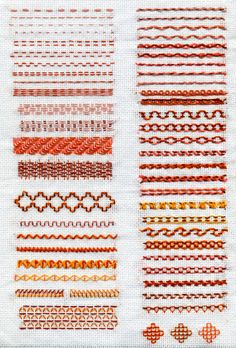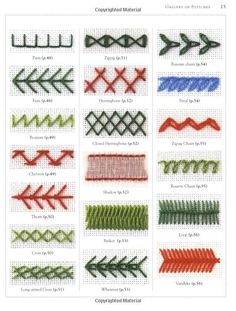Different Type of Embroidery Stitches
Embroidery is a centuries-old technique that involves decorating fabric with needle and thread to create intricate patterns, motifs, and textures. In fashion design, embroidery stitches serve as a versatile tool for adding embellishments, detailing, and artistic expression to garments and accessories. This class note explores various types of embroidery stitches used in fashion design, covering their techniques, applications, historical significance, and contemporary adaptations.

Historical Context
Embroidery has a rich history spanning cultures and civilizations, with evidence of early forms dating back to ancient Egypt, China, India, and the Mediterranean region. Historically, embroidery was used to adorn clothing, textiles, and household items, often showcasing the skill and status of artisans and their cultural heritage. Over time, embroidery techniques evolved, influenced by trade routes, artistic movements, and technological advancements, shaping the diverse repertoire of stitches used in fashion today.
Basic Embroidery Stitches
1. Running Stitch:
- Description: Simplest of all stitches, created by running the needle and thread through the fabric in a straight line.
- Applications: Outlining, borders, and creating fine lines in embroidery designs.
2. Back Stitch:
- Description: Strong and versatile stitch where the needle goes back one stitch length, then forward the same length.
- Applications: Outlining, creating continuous lines, and adding definition to embroidered motifs.
3. Satin Stitch:
- Description: Dense stitches placed closely together to fill shapes with smooth, satin-like texture.
- Applications: Filling solid areas, creating petals, leaves, and geometric shapes.
4. Stem Stitch:
- Description: Rope-like effect created by alternating the needle position from left to right along a line.
- Applications: Outlining stems, vines, and creating curved lines with a textured appearance.

5. Chain Stitch:
- Description: Looping stitch where the needle passes through the fabric, creating a series of connected loops.
- Applications: Creating outlines, borders, and filling shapes with textured patterns.
Advanced and Decorative Stitches
1. French Knot:
- Description: Small, raised knots formed by wrapping the thread around the needle several times before inserting it back into the fabric.
- Applications: Adding texture, creating small dots, and embellishing flower centers.
2. Bullion Stitch:
- Description: Long, twisted stitches wrapped around the needle multiple times before pulling through the fabric.
- Applications: Creating dimensional effects, flower petals, and intricate scrollwork.
3. Feather Stitch:
- Description: Open, V-shaped stitches worked along a line, often alternating sides to create a feathery effect.
- Applications: Embellishing seams, creating borders, and decorative accents on garments.
4. Couching:
- Description: Technique where a thicker thread or yarn is laid across the fabric and stitched down with a finer thread.
- Applications: Adding texture, creating bold lines, and securing decorative threads or ribbons.
5. Cross Stitch:
- Description: X-shaped stitches forming a grid-like pattern on the fabric, typically worked in a two-by-two square.
- Applications: Creating detailed patterns, borders, and decorative motifs with a pixelated appearance.
Regional and Cultural Embroidery Stitches
1. Kantha Stitch (India and Bangladesh):

- Description: Running stitch used for quilting and embroidery, creating intricate patterns and motifs.
- Applications: Sarees, scarves, and household textiles, showcasing storytelling through stitched designs.
2. Sashiko Stitch (Japan):
- Description: Running stitch worked in geometric patterns for reinforcement and decoration on clothing and textiles.
- Applications: Traditional garments like kimonos and home decor items, emphasizing simplicity and functional beauty.
3. Herringbone Stitch (West Africa):
- Description: Diagonal stitches resembling the bones of a herring fish, creating a textured and durable embellishment.
- Applications: Adorning traditional attire such as dashikis and boubous, symbolizing cultural identity and craftsmanship.
Contemporary Applications in Fashion Design
1. Haute Couture and Designer Collections:
- Intricate Detailing: Handcrafted embroidery stitches used to create elaborate designs and personalized embellishments.
- Statement Pieces: Couture gowns, jackets, and accessories adorned with unique embroidered motifs, showcasing craftsmanship.
2. Ready-to-Wear and Pret-a-Porter:
- Mass Production Techniques: Computerized embroidery machines replicate intricate stitches and designs for mass-produced garments.
- Embroidered Patches: Ready-made clothing featuring embroidered patches or motifs for a customizable and trendy appeal.
3. Accessories and Home Decor:
- Handcrafted Artistry: Embroidered accessories like handbags, scarves, and cushions featuring detailed stitch work for luxury and artisanal charm.
- Interior Design: Embroidered curtains, table linens, and wall hangings adding elegance and personalization to living spaces.
Innovation and Technology

1. Digital Embroidery: Computerized machines capable of replicating complex embroidery designs with precision and speed.
2. Mixed Media: Incorporating embroidery with other techniques such as printing, beading, and appliqué for multidimensional effects.
3. Sustainability: Using eco-friendly threads, upcycled fabrics, and ethical production practices to promote sustainable fashion choices.
Conclusion
Embroidery stitches in fashion design represent a fusion of artistry, tradition, and innovation, offering endless possibilities for creating distinctive and expressive garments and accessories. By mastering different embroidery stitches, understanding their cultural contexts, and embracing technological advancements, fashion designers can elevate their designs with intricate embellishments that resonate with craftsmanship and creativity. As fashion continues to evolve, embroidery stitches remain a timeless and versatile tool for transforming fabrics into wearable works of art, bridging the past with the present in the dynamic world of fashion.
